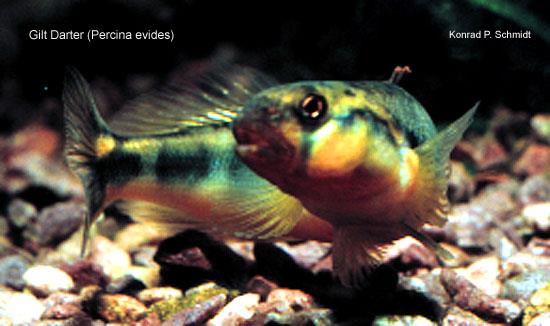Fish Iowa - Fish Species - Gilt Darter

Characteristics
A moderately slender darter with a series of 7 to 9 dark blotches along the mid-side and a narrow, dusky vertical bar under the eye. Blotches vertically elongated and continuous with dark cross-bars on the back. One or more enlarged and modified scales between the pelvic fin bases; breast and midline of belly is otherwise naked or with enlarged and modified scales. Gill covers are not broadly connected with a membrane across throat; distance from the membrane notch to the front of the upper lip is much less than the distance from the notch to front of pelvic fin base. Lateral line complete, with 64 to 76 scales. Dorsal fins with 11 to 13 spines and 12 or 13 rays. Anal fin with 2 stiff spines and 10 rays. Back brownish-olive with squarish dark cross-bars. Sides orange-yellow with greenish-black blotches. Fins dusky or clear, without definite markings. Breeding males have an orange-red throat and lower surface of their head and body and fins tinged with orange; these colors are often somewhat developed in nonbreeding males and in females. Adults are commonly 2.3- to 3.3-inches long to a maximum of about 3.5-inches.
Foods
- No results found
Expert Tip
- No results found
Details
The Gilt Darter usually lives in clear, large creeks and small to medium-sized rivers with moderate to swift current and substrates of rubble, gravel, sand and scattered rubble free of vegetation and silt. It is found in deep, fast, rocky riffles and chutes. In parts of Missouri, the Gilt Darter is found in the strong current of deep riffles and chutes with mostly gravel bottoms and sometimes near beds of eel grass and pondweed.
Often found in the middle to lower parts of clean gravelly riffles, researchers report that the Gilt Darter spawns in the upper portions of riffles with sand and gravel substrates scattered with larger cobbles and boulders. The range of the Gilt Darter was once rather widespread, but has been reduced in many states due to impoundment, excessive siltation and industrial pollutants.
Sources:
Loan-Wilsey, A. K., C. L. Pierce, K. L. Kane, P. D. Brown and R. L. McNeely. 2005. The Iowa Aquatic Gap Analysis Project Final Report. Iowa Cooperative Fish and Wildlife Research Unit, Iowa State University, Ames.
Pflieger, W.L. 1997. The fishes of Missouri. Missouri Department of Conservation, Jefferson City, Missouri. 372 pp.
Photo credit: photo courtesy of Konrad P. Schmidt, copyright Konrad P. Schmidt.
Distribution Map

Fishing is not allowed for this species.
If you catch this species, immediately return it to the water with as little injury as possible.